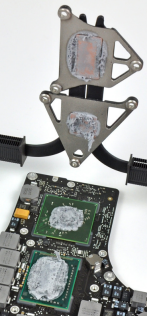Hey, Apple ... Don't start getting sloppy!

The other day I blogged about iFixit's teardown of Apple's latest MacBook Pro refresh and passed on the team's concerns that Apple has used too much thermal paste between the critical components such as the CPU and the heatsinks. At the time I didn't look that closely at the photos, but today I have, and it's clear that Apple has used way too much thermal paste. When it comes to thermal paste, you CAN have too much of a good thing!
Hey Apple! This isn't the time to start getting sloppy!
The purpose of thermal paste (also known as thermal grease) is to act as a conductor of heat between a hot thing (such as a CPU or GPU) and something designed to carry the heat away (a heatsink). Thermal paste, which is usually a suspension of an aluminum, silicon, zinc or beryllium ceramic (or sometimes silver or aluminum metal) in a silicone gel, is used because air is a pretty poor conductor of heat, and no matter how well you polish mating surfaces of the CPU and heatsink, you'll still end up with tiny air gaps because of imperfections in the surface. These air gaps can then lead to localized overheating, something which is bad. Overheating leads to component failure, something which is really bad. Thermal paste is a quick, simple and cost-effective way to fill in these air gaps and make a good join between the two surfaces.
Note: I've used liquid-metal thermal pastes based on a gallium alloy which are very effective but messing about with electrically conductive liquid-metals near expensive motherboards and CPUs has the potential to go very wrong!
So if air gaps are bad, and thermal paste is good, what's wrong with too much thermal paste? Quite simply it is that while thermal paste is a good thermal conductor compared to air, it's nowhere near as good a conductor as, say, a copper heatsink. Too much thermal paste itself can be self-defeating and itself cause hotspots to develop.
So how much is enough thermal paste? Well, here's how I apply it. I'll take a small dot about the size of a grain of rice and pop that on the middle of the chip. Then I'll cover the end of my finger with a clean piece of plastic food wrap and then use this to smear the paste thinly over the surface of the chip. Almost see-through is the ideal thickness I'm looking for.
So, if a little thermal paste is what you're looking for, and a lot is not good, how much did Apple apply? Take a look at these high-resolution images supplied by iFixit. Here is the CPU and GPU:
Here's the graphics switching chip:
And there's the Thunderbolt controller:
Note: Click for larger images.
The thermal compound on these chips looks like it's been applied with a shovel. It's too much ... way too much. I'm not saying that this WILL lead to problems (only testing or time will give us that answer), but it's certainly sloppy to throw around this much thermal paste. It also seems like a recent development at Apple. iFixit have never mentioned Apple using thermal paste in a sloppy fashion in the past (although the MacBook Air that was stripped down showed signs of having more thermal paste than needed), and I don't recall seeing Apple every use this much thermal paste. This, combined with the stripped screw head and an unlocked infrared ZIF socket that iFixit found in a single high-end system is something that Apple should be worried about.
[UPDATE: Seems like Apple got sloppy with the thermal paste on MacBook Pros back in 2006 too.]
